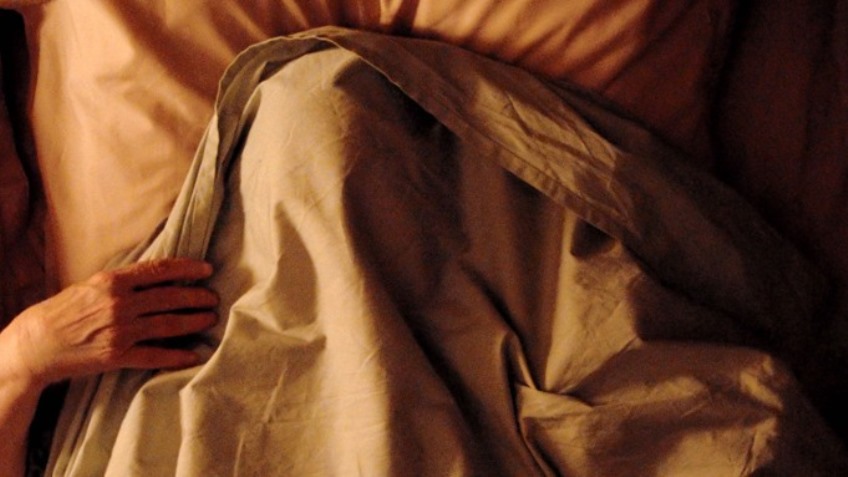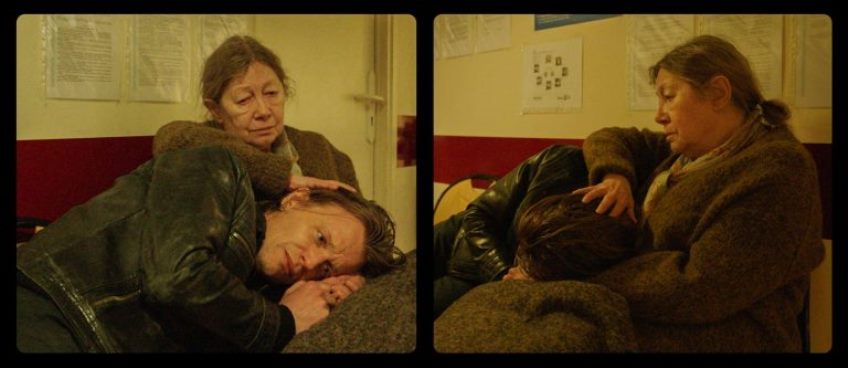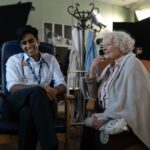Joyce Glasser reviews Vortex (May 13th, 2022) Cert 15, 142 mins.
Gaspar Noé’s new film, Vortex, is “dedicated to all those whose brains will decompose before their hearts.” The metaphorical meaning is powerful, but taken literally it is a devastating, compelling snapshot of old age: the Mother (as she is called in the credits) at the centre of the film has dementia and her husband, the Father has heart disease. The well-chosen title invites us to think of the onslaught of this all-consuming combination of failed mind and heart as a whirlwind sucking everything into its black hole.
Vortex might remind you of Michael Haneke’s Academy Award winning masterpiece, Love, in which a devoted, elderly, professional couple come to terms with the wife’s stroke. It will not remind you of Noé’s own film entitled Love, which purports to tell the story of a young couple’s romance through unsimulated sex – in 3D. The enfant terrible of 21st century French cinema, Noé’s films are 18 rated for sex and violence.
In Vortex the only sex is a pat of affection, and the only violence is the ravages of time which earned it a 15 rating. Noé is now 58, the age in which middle-aged children lose their sense of security and realise that the parent-child role has altered. The subject matter, however, has not affected Noe’s uncompromising style. Vortex is, in its way, just as challenging and difficult to watch as his 18-rated Irreversible, but for some audiences it will be more rewarding.

The film seems highly personal and not only because there is a middle-aged son in the cast of four. Stéphane (Alex Lutz) a struggling film editor, has a drug habit and a young, hyperactive son named Kiki (Kylian Dheret). His parents remain as undemanding and non-judgmental as possible. Stéphane tries to be a good son, but he is overwhelmed by the responsibility of sorting out his distressed parents.
When the film opens, we see the Mother and the Father open their respective windows to gesture one another to meet for dinner, from opposite sides of a courtyard in a lovely apartment block, as though they are neighbours, not co-inhabitants. They dine on a small balcony covered in bright flowers and the man fills the woman’s glass with wine. They make a toast to life.
There is not much plot. A retired psychiatrist (screen legend Françoise Lebrun), the “Mother,” has Alzheimer’s, and her lucid days, represented by the aforementioned opening scene – are over. For the rest of the film, the unwashed dishes add to the clutter of the apartment and the flowers on the balcony begin to wilt.
The solitary Mother, who wanders out of the flat, getting lost in a local bric-a-brac shop, distracting the Father (film writer-director Dario Argento), a film critic and writer, from his work on a book about dream symbolism and cinema. The Mother has lost her capacity for speech or finds it so difficult she can only mumble occasional words. The Father still enjoys entertaining friends (including a departing mistress) with wine and lively shoptalk, despite his heart problem.
What seems to unite their separate lives is the couple’s complex schedule of medicine. There is a bit of black comedy as they mix up their pills and forget their doses. Comic though it may be, we look on with genuine alarm, as the Mother, a former doctor, stirs up a potion to administer to the Father who is annoying her.
That this is a film about age is signalled up front with the dates of birth below the names of the main characters in the opening credits: Lebrun (the Mother), 1944, and Argento (the Father), 1940. That the film is about the solitude of infirmity and death is signalled by a split screen running through most of the film.
This device is not gimmicky, but in the hands of cinematographer Benoit Debie (who has previously worked with both Noé and Argento), is expressive, disquieting and functional. According to Peter Read’s Times Literary Supplement review of Alex Danchev’s new biography of René Magritte, the painter would hide faces behind veils and masks, or, in The Listening Room, fill a room with a giant apple to suggest non communication and solitude. The haunting presence of the familiar elements (the room, the humans) creates a feeling of the uncanny. Noé’s split screen can be given a similar reading.
Noé also uses the split screen technique to create tension, as when the Father is taking a shower, oblivious to what is going on in his study where he has just been tapping away on an old typewriter. Beyond the door of the steamy bathroom, on the other side of the screen, the Mother is tearing up his manuscript. Whether she really believes she is tidying up or is subconsciously expressing her irritation with her husband, is ambiguous. The technique is used to express tenderness, as when the sparring couple suddenly grasp each other’s hands across the divided screen.
Lebrun is astonishing, finding her way into a dark place that is so convincing we would be surprised to hear her speaking coherently in a publicity interview. Argento is, among other things, an actor and critic, but he is primarily a film director, best known for his horror films of the 1970s and ‘80s, including Suspira (1977), remade in 2018 by Luca Guadagnino. His performance is heart breaking; as though he were looking ahead into a possible version of his own life, or the life of someone like him.
Like Haneke’s Amour, the well-lived-in apartment is, with just a few exceptions, the sole location. Jean Rabasse’s production design is exemplary as the apartment, the repository of this intellectual couple’s life, becomes a character in the film. Stuffed full of the photos, books, albums, films, and files that the Father cannot bear to leave behind for a cramped nursing home, Noé leaves us to ponder the fate of our own cherished belongings, the silent companions and witnesses to our lives.




